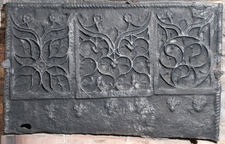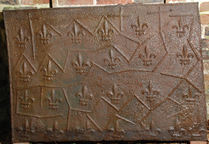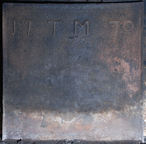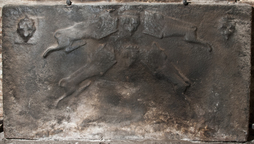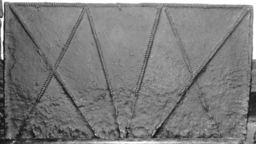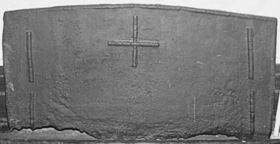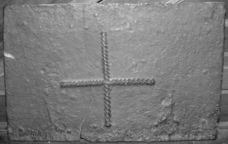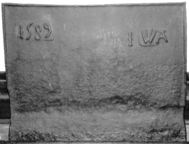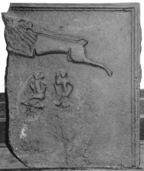-
99
Description: Quasi-rectangular; twisted rope edging (top and sides); three gothic panels arranged horizontally, the centre one wider than the other two, each panel a symmetrical arrangement of tracery patterns with an inverted ogee arch on top incorporating two flowers; below are six, irregularly spaced fleurs-de-lys.
Notes: The panels were probably derived from a dismantled wooden chest or hutch table, c.1500. Their gothic style belies the probable age of the fireback, such chests already being old when their parts might have been re-used. The same panels are on a fireback at East Grinstead Museum.
- Decoration tags:
- rectangular (shape)
- rope (edging)
- carved pattern panels
- architectural
Manufactured: in the early- to mid-16th century in the Weald area of England.
Current location: Nymans, Staplefield Road, Handcross, Slaugham, West Sussex, England.
Museum number: 1206065 (part of the National Trust museum group)
- Attached to series:
- Gothic panel series
- Furniture stamp firebacks
-
311
Description: Quasi-rectangular; twisted rope edging (top and sides); fleur-de-lys stamp repeated 25 times in four rows (6-6-6-7), interspersed with a length of twisted rope repeatedly stamped between each row and sometimes between fleurs; three rope crosses near top corners.
Notes: The fleurs are identical to others from the ‘Pounsley’ series.
- Decoration tags:
- rectangular (shape)
- rope (edging)
- simple stamps
- carved stamps
- heraldic
- objects
Manufactured: in the mid- to late-16th century possibly at Pounsley Furnace, Framfield in the Weald area of England.
Current location: Nymans, Staplefield Road, Handcross, Slaugham, West Sussex, England.
(part of the National Trust museum group)
- Attached to series:
- Pounsley series
- Fleur-de-lys firebacks
-
101
Description: Rectangular; cavetto moulded edging; date aplit by intitials placed centrally at top.
Inscription: 17 TM 70
- Decoration tags:
- rectangular (shape)
- cavetto (edging)
- individual letters
- individual numbers
- text
Manufactured: in 1770 possibly in the Weald area of England.
Current location: in private hands, Hartfield, East Sussex, England.
- Attached to series:
- Date & initials firebacks
-
1240
Description: Rectangular shape; twisted rope edging (top and sides); top centre, crowned shield bearing initials KH above a fleur-de-lys between an angled leopard passant guardant sinister (on the left) and an angled leopard passant (on the right); the group repeated below at a steeper angle; in each top corner, a crowned shield bearing initials KH, above a fleur-de-lys, the left shield over pressed.
Notes: One of a large series employing distinctive Tudor heraldic stamps. The absence of one of the legs of the leopard passant indicates that this is an example of a later use of the stamp, earlier castings showing the stamp in more complete condition. The only examples of this fireback that have been noted are similarly poor copies lacking definition. Other examples are at Sackville House, East Grinstead and at Nymans, Handcross, both in Sussex.
Copies of this fireback are known.
Inscription: KH [x4]
- Decoration tags:
- rectangular (shape)
- rope (edging)
- simple stamps
- carved stamps
- heraldic
- royal
- text
- objects
Manufactured: in the mid- to late-16th century in the Weald area of England.
Current location: in private hands, Hartfield, East Sussex, England.
- Attached to series:
- Royal series
-
103
Description: Rectangular; flanged or astragal and fillett edging; female portrait in a medallion of three concentric rings; date split between four corners
Notes: An unusually small stoveplate.
Inscription: 1 6 [?0] 4
- Decoration tags:
- rectangular (shape)
- astragal & fillet (edging)
- whole carved pattern
- individual numbers
- pictorial
- text
- humans
Manufactured: in 1604 possibly in the Eifel area of Germany.
Current location: Haslemere Educational Museum, Haslemere, Surrey, England.
(part of the Haslemere Educational Museum museum group)
- Attached to series:
- Stoveplates
-
112
Description: Rectangular with twisted rope edging; straight lengths of rope re-stamped to make longer lengths in the shape of a saltire on each side and a 'V' in the middle.
Notes: The arrangement of the rope lengths may have an apotropaic significance, a double 'v' alluding to the Virgin Mary. Formerly part of the Ade Collection (from Grove Hill, Hellingly, Sussex).
- Decoration tags:
- rectangular (shape)
- rope (edging)
- simple stamps
- apotropaic
- objects
Manufactured: in the mid- to late-16th century in the Weald area of England.
Current location: Hastings Museum and Art Gallery, John's Place, Bohemia Road, Hastings, East Sussex, England.
Museum number: HASMG: 1952.51.20 (part of the Hastings Museum museum group)
- Attached to series:
- Rope design firebacks
-
114
Description: Quasi-rectangular shape with low-curved convex top; edging (top and sides)formed of lengths of dowel grooved laterally and helically; upper centre, cross formed of the same dowel; at each side, tandem arrangement of longer dowel, similarly grooved.
Notes: The base board appears to be the same size and shape as that of a fireback at Plaxtol, Kent (no. 587), which also has the same edging; and the grooved dowels are also on a fireback with dagger stamps at Lewes; the cross will have been intended to have apotropaic significance. Formerly part of the Ade Collection (from Grove Hill, Hellingly, Sussex).
- Decoration tags:
- rectangular (shape)
- grooved dowel (edging)
- simple stamps
- apotropaic
- objects
Manufactured: in the mid- to late-16th century in the Weald area of England.
Current location: Hastings Museum and Art Gallery, John's Place, Bohemia Road, Hastings, East Sussex, England.
Museum number: HASMG: 1952.51.21 (part of the Hastings Museum museum group)
- Attached to series:
- Grooved dowel series
-
115
Description: Plain rectangular plate with cross formed of a single length of twisted rope placed twice.
Notes: Despite the simple form, the likely Christian symbolism is very evident. Formerly part of the Ade Collection (from Grove Hill, Hellingly, Sussex).
- Decoration tags:
- rectangular (shape)
- none (edging)
- simple stamps
- apotropaic
- objects
Manufactured: in the 16th century in the Weald area of England.
Current location: Hastings Museum and Art Gallery, John's Place, Bohemia Road, Hastings, East Sussex, England.
Museum number: HASMG: 1952.51.17 (part of the Hastings Museum museum group)
- Attached to series:
- Rope design firebacks
-
116
Description: Rectangular; twisted rope edging (top and sides); top left, date carved on block; top right, individual letter 'I' followed by 'WA' carved on block.
Notes: The same date stamp appears on a group of multi-facetted, arched firebacks bearing the crowned Tudor arms within a Garter. Formerly part of the Ade Collection (from Grove Hill, Hellingly, Sussex).
Inscription: 1589 I WA
- Decoration tags:
- rectangular (shape)
- rope (edging)
- carved stamps
- date stamp
- text
Manufactured: in 1589 in the Weald area of England.
Current location: Hastings Museum and Art Gallery, John's Place, Bohemia Road, Hastings, East Sussex, England.
Museum number: HASMG: 1952.51.42 (part of the Hastings Museum museum group)
- Attached to series:
- 1589 series
-
126
Description: Fragment; rectangular; astragal and fillet edging (top and sides); oblique lion passant above two left facing 'imps', one with right arm raised, the other with both arms lowered.
Notes: One of the legs of the leopard is missing, suggesting that the stamp, which appears complete on many firebacks, was well used and had been damaged; this suggests a relatively late use of this stamp.One of a large series all bearing royal heraldic stamps, but unusual in the use of moulded edging, twisted rope being normally used for this series. The surviving elements were probably mirrored on the missing half. Formerly part of the Ade Collection (from Grove Hill, Hellingly, Sussex).
- Decoration tags:
- rectangular (shape)
- astragal & fillet (edging)
- carved stamps
- heraldic
- animals
- humans
Manufactured: in the mid- to late-16th century in the Weald area of England.
Current location: Hastings Museum and Art Gallery, John's Place, Bohemia Road, Hastings, East Sussex, England.
Museum number: HASMG: 1952.51.12 (LA 760) (part of the Hastings Museum museum group)
- Attached to series:
- Royal series
